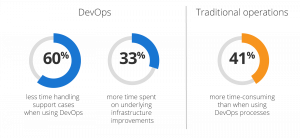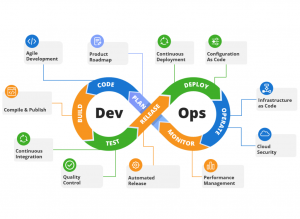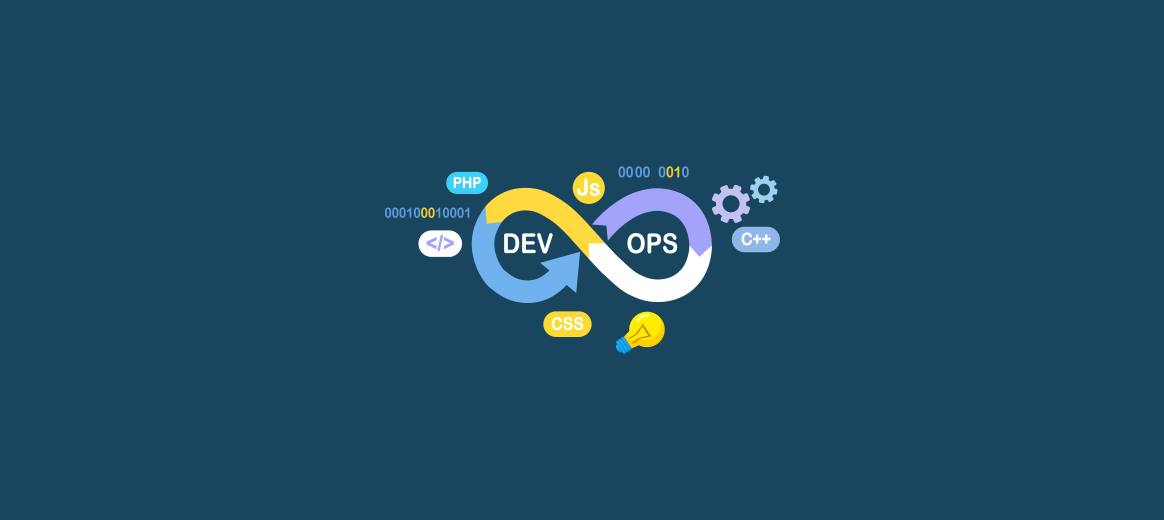Balancing the need for customer requests and upgrades with the demands of software development and deployment is a delicate process. DevOps – short for development and operations – is a modern solution to an age-old problem: providing significant improvements without sacrificing quality and speed.
At its core, DevOps is a cultural shift that brings together traditionally siloed roles like software development, IT operations, and security. Using DevOps results in 60% less time handling support cases and 33% more time spent on underlying infrastructure improvements. Overall, traditional operations are 41% more time-consuming than when using DevOps processes. In this article, we’ll explore how DevOps delivers solutions that evolve according to customer needs.

What is DevOps?
DevOps is a framework that combines software development and IT operations to streamline the process of delivering software applications into production. It merges cross-functional practices, tools, and cultures to improve products faster than traditional software and infrastructure management processes while increasing quality and reliability.
Developers, IT operations, and other stakeholders collaborate to plan, build, deploy, operate, and monitor software with rapid feedback loops and continuous delivery. By automating repetitive tasks and enabling continuous integration and continuous delivery (CI/CD), DevOps promotes a culture of perpetual constant improvement and learning. The entire cycle is customer focused, and the ultimate goal is to deliver better higher quality software faster and at a lower cost.
Features of an Effective DevOps Process
Just as a car engine propels vehicles forward, an effective DevOps methodology drives results that accelerate software delivery, enhance product quality, and improve overall efficiency in software development and deployment. Typical features of effective DevOps practices include:
Continuous Data Gathering and Analysis
Data provides the foundation for the entire DevOps lifecycle. Effective analysis of data – often best-achieved through a mixture of AI and human input – can identify opportunities for improvements.
For example, customer success teams proactively monitor the operational effectiveness of software to maximize productivity gains for customers. With full visibility, organizations can track key metrics for each customer and compare them to industry reference metrics. Identifying below-average or negative trend results triggers an investigation into the root cause and ensuing action. Customer-wide analytics helps software companies determine the impact and reach of addressing an issue.
Impact-Driven Product Roadmap
Product roadmaps align stakeholders, prioritize work, and provide clear direction and enhance collaboration to ensure delivery of a product that addresses the needs of customers. During the DevOps lifecycle, roadmap adjustments come after the evaluation of performance issues or customer requests. Each product release aims to maximize value. Areas that may be considered include:
- Improvements in performance metrics that will result from the upgrade
- Effort required to evaluate efficiency
- Potential reach and impact
Agile Culture
Agile development describes the development approach of completing works in short time increments, referred to as sprints. Every sprint includes all coding, testing, and quality control verification – resulting in an accelerated pace for software development. Microsoft’s Developer Tool division, for instance, has a three-week sprint schedule.
DevOps principles closely align with agile software development, which emphasizes collaboration, flexibility, and incremental delivery. Many of the goals are similar – prioritizing responsiveness to customers, faster deployment times, and cross-functional teamwork.
Continuous Development
Shipping deployable software within a short timeline requires a controlled process with a low tolerance for errors and labor-intensive manual processes. Frequent but smaller updates make faster deployment possible while reducing the risk of each deployment. When teams receive feedback faster, they can isolate faulty code quickly and fine-tune the software to meet customer needs. High-performing DevOps teams release software 417 times more often than low performers.
DevOps engineers usually leverage the following principles:
- Continuous integration (CI): CI emphasizes regular code merges into a central system where automated builds and testing occur. By adding code in smaller doses regularly, developers can find and resolve bugs quickly, shortening the time required to validate new software releases.
- Continuous Delivery (CD): CI feeds into continuous delivery (CD), which automates the testing, configuration, and deployment pipelines after the build stage. All code goes through comprehensive testing to create a deployment-ready release quickly and safely.
- Infrastructure as Code: An agile culture extends to infrastructure changes, which are sometimes overlooked in favor of focusing on code and application features. To ensure stability and manageability, organizations can apply incremental changes and agile methodologies for infrastructure, responding quickly to changing requirements. Treating infrastructure like code increases the efficiency of managing underlying infrastructure resources.
Teams that recognize the importance of continuous improvement tend to have better organizational performance than teams that don’t.
Flexibility with Quality Control
Despite the rapid delivery in a fully integrated DevOps approach, code undergoes exhaustive automated and manual tests in mirror copies of production environments. Extensive testing ensures that changes work seamlessly with minimal disruption to business operations.
Successful DevOps frameworks allow flexibility to respond to customer needs and offer a choice of optimal times to upgrade. When updates are available, customers can defer and reschedule them as needed. Rollouts occur with minimal change risk, and customers have the opportunity to schedule training on new functionality or processes.
Enhance Software Quality with DevOps
DevOps takes a collaborative and proactive approach combined with automated processes to optimize planning, building, deployment, testing, and monitoring. Not only does the DevOps methodology respond to customer needs and market trends quickly, but it increases the efficiency and security of software solutions. Instead of going through long cycles of manual testing, code and infrastructure changes are deployed faster and more reliably, while going through extensive quality control checks.
SoftCo’s DevOps cycle supports speed, reliability, and high-quality implementation that has generated an industry-leading end-to-end procure-to-pay solution. These practices have yielded 100% project success rates with features like faster invoice approval workflows and an unrivalled smart matching engine that handles the most complicated scenarios. Implementing DevOps accelerates the delivery of meaningful software upgrades to the benefit of customers.



